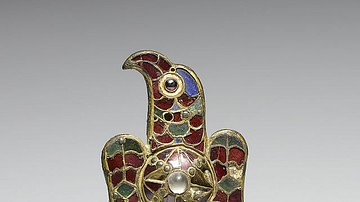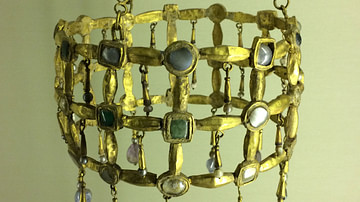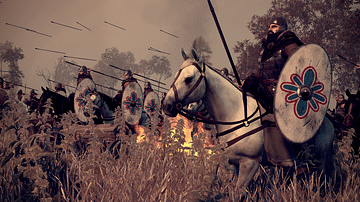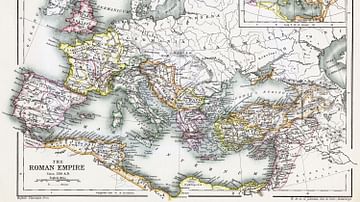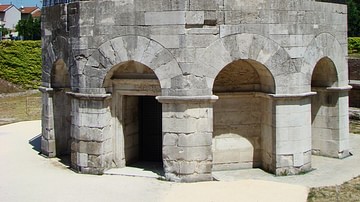
Athanaric (died c. 381 CE) was a king of the Thervingi Goths (better known as the Visigoths) and, according to some sources, the first and greatest king. He was of the noble Balts family of the Thervingi tribe and a relative of the later king of the Visigoths Alaric I (reigned 395-410 CE), best known for the sack of Rome. As the ruling judge of his tribe, it was Athanaric's responsibility to foster and encourage the ancient pagan faith of his people which informed their cultural identity and, because of this, he violently persecuted those Goths who embraced Christianity in the 4th century CE.
According to legend, he had sworn to his father, Aoric, that he would never set foot on Roman soil and would remain an enemy of Rome. This story has been modified by recent scholarship to suggest that Athanaric's position as judge prevented him from leaving his tribal lands or encouraging cross-cultural exchange and is supported by the fact that, once he was no longer a judge, he was received at Constantinople as an honored guest of the Eastern Roman emperor Theodosius I c. 381 CE where he died. His civil war with the Gothic chieftain Fritigern divided the Goths, but his military skill in this conflict, as well as those engagements with the Roman emperor Valens, made him a hero among his people.
Athanaric the Judge
The king of the Goths was known as a reiks (pronounced "rix" or "rex" and translated as "judge") and, according to the work known as the Ostrogothic Origo, co-ruled with another who held the title of dux (a word meaning "leader" or "general" and, later, becoming "duke"). The reiks was responsible for governing the people and maintaining tribal customs and beliefs, while the dux was a military commander in charge of the army.
Athanaric's grandfather, Ariaric, seems to have held both positions or, at least, was a judge who also waged war. According to the historian Herwig Wolfram, Ariaric "was the most eminent Goth of his time" and "may have been the supreme commander in the defensive war against the Romans" (Athanaric the Visigoth, 264). Athanaric's father was Aoric, who would inherit the title of judge but may have originally been general of the army (the dux to his own father's reiks) and who fought against Roman incursions into Gothic territory.
In 332 CE Aoric was sent (or went willingly) to Constantinople as a hostage to guarantee the compliance of the Goths with a peace treaty recently signed with Rome. He was so well respected that the emperor Constantine the Great (272-337 CE) had a statue of him erected to honor him, and he was treated well during his stay among the Romans.
It is not known what he experienced in Constantinople but, whatever it was and whatever honors were shown him, nothing made him like Roman culture any more than he had when he fought against it under his father Ariaric. Wolfram writes, regarding this:
Athanaric's father did not overcome his hatred of all things Roman, or it may have been that he grew to believe that the Roman world presented an extreme threat to the traditional tribal structure of the Goths. At some point in time, probably after returning home following Constantine's death in 337, the Gothic prince undertook to instill in his son, Athanaric, an anti-Roman political outlook. It is known that Athanaric not only understood this to include repelling the Romans in one of their offensive wars but also that he sought to counter Romanization and the accompanying internal crisis of the Goths through a bloody persecution of the Christians among them in 369-372. (Athanaric the Visigoth, 265)
Following Aoric's death, Athanaric became judge in his place and may have appointed a general or may have ruled alone. At what date he assumed rule is unknown, but he was recognized as the king of his people in 365 CE when the Roman usurper Procopius rebelled against Valens, won a sizeable portion of the army to his cause, and took control of Constantinople while Valens was away on campaign in Asia Minor. In accordance with the treaty between the Goths and the Romans of 332 CE, Procopius (claiming a direct relationship with Constantine) insisted that Athanaric send troops to help him maintain his position should Valens return. Three thousand troops were sent but arrived at Constantinople in May of 366 CE to find Procopius had been assassinated.
They turned around and marched towards home but were subdued by the Roman army under Valens' authority as enemies of the state who had joined Procopius' side. The 3,000 Goths were interred while it was decided what to do with them. Athanaric wrote to Valens demanding their release, and Valens responded by sending ambassadors to hear the king's side of the story.
Although Athanaric produced proof that Procopius had presented himself as the legitimate ruler of the Eastern Roman Empire, nothing would be done about returning the troops. Wolfram writes, "Valens, who was taking bloody revenge on the followers of his enemy, had not the slightest intention of sparing barbarians and did not hand over the captives. Nothing more is heard of them" (History of the Goths, 66). Athanaric's role as judge, and vow to his father, had guaranteed an anti-Roman stance prior to this event but, afterwards, his policy became more hardened; Rome could not be trusted and should not be tolerated.
Athanaric & Valens
The emperor Valens (r. 364-378 CE) was a vain and proud man who sought the kind of glory in battle which had enshrined earlier emperors like Caesar or Pompey. The Roman officer and historian Ammianus Marcellinus (330-395 CE) wrote of him:
He was an immoderate covetor of great wealth; impatient of labor, he affected an extreme severity, and was too much inclined to cruelty; his behavior was rude and rough; and he was little imbued with skill either in war or in the liberal arts. He willingly sought profit and advantage in the miseries of others and was more than ever intolerable in straining ordinary offences into sedition or treason. (618)
The Goths, fearing that Valens might carry his reprisals against the allies of Procopius into their territories, placed themselves firmly under Athanaric's leadership and formed a confederacy of different tribes for defense. Valens interpreted their mobilization as an act of war and, in 367 CE, he launched his offensive. The Romans marched into the Thervingian territories to subdue the barbarian enemy but could not seem to find them anywhere. Athanaric's forces were extremely mobile and knew the region well and so were able to evade the Romans easily.
Valens, for his part, seems to have believed that he had the element of surprise on his side and that the Goths had no idea he had even invaded. Athanaric drew the Roman forces deeper and deeper into his territory and then engaged in guerilla warfare tactics, striking the Romans without warning on every side and then vanishing as quickly as they had come. The Romans were able to kill some of the Goths and destroyed the fields and crops they came to but could gain no advantage against an invisible enemy who only appeared in order to strike. Valens had invaded the region in the spring of 367 CE and, as Ammianus notes, returned in the fall "without having inflicted any serious damage on the enemy or having suffered any himself." He decided that the next time he would try a different tactic and crush the Goths completely.
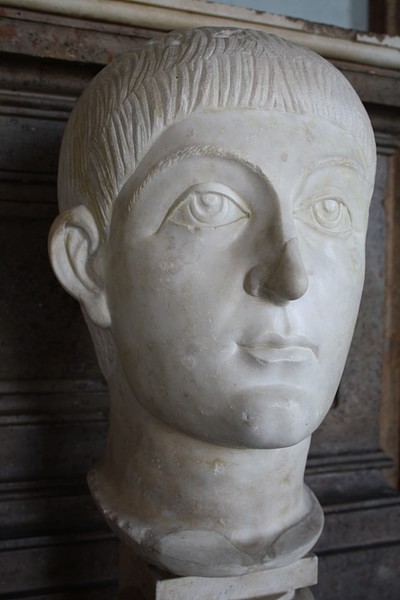
The rains were heavy throughout the early part of 368 CE and the Danube River flooded, as did the plains and forests surrounding it, and Valens could not mount another campaign against Athanaric simply because he could not cross the river. The floods caused problems for the Goths as well, as their crops were washed away and the harvest in the fall was poor. Trade with the Romans, of course, had ceased and food was scarce. Still, Athanaric refused to come to terms with Valens and, in 369 CE, the Romans again crossed the Danube and invaded.
Athanaric used the same strategy he had employed two years before and again drew the Roman troops into terrain that favored the mobile Goth fighting force but hampered the Roman battle formations. The Romans experienced more heavy resistance than they had in 367 CE, including the addition of Greuthingi cavalry who had allied themselves with the tribes under Athanaric. The guerilla tactics of the Goths continued as the Romans marched deeper and deeper into their territory until, finally, Athanaric decided to make a stand and engage them in battle.
The Romans tried the tactic of dividing their forces to encircle the smaller army of the Goths but were unsuccessful. Athanaric directed his men at the center of the Roman line but was repelled. The Romans then re-grouped and launched a direct assault that drove the Goths from the field. The Goths were defeated but it was in no way a decisive Roman victory, as the "vanquished" army simply vanished into the surrounding forest.
It is possible that Athanaric considered prolonging the conflict and inviting Valens back another time for a third round, but his people were starving and the Romans had destroyed a significant amount of arable land in their invasions. Athanaric, therefore, sent word to Valens that he was interested in opening negotiations for peace. Valens sent word back that Athanaric should come to Constantinople for the peace talks but, of course, Athanaric could not do this because he had sworn to his father never to set foot on Roman soil and, further, as judge, he could not leave his region. Wolfram writes:
This judge was not allowed to leave the tribal territory, which made him the most unsuitable leader for an offensive war. Rather, he was responsible for the defense of the land of Gothic people against domestic and foreign enemies. (History of the Goths, 67)
Valens refused to compromise his position as emperor and meet with a barbarian chieftain, who was dictating the terms according to barbarian superstitions, in barbarian territory. Still, Valens realized that the war was costly and, after three years, he had not one single decisive victory to show for his troubles. It was negotiated that the two leaders would meet on neutral ground acceptable to both and so, as Wolfram writes:
In September 369 Valens had to make peace with Athanaric as an equal; he had to recognize Athanaric's refusal (on religious grounds) to set foot on Roman soil and he had to negotiate for an entire day on a boat anchored at a 'suitable place' in the middle of the Danube. The manner in which the peace was concluded prompted lasting annoyance among the Romans. (History of the Goths, 68)
The annoyance Wolfram mentions was due not only to the emperor's compromise of meeting a barbarian chief on a boat instead of crushing him with Roman military might but also to the terms of the peace. The kind of open trade that had existed between the Romans and the Goths was restricted to two points on the Danube (in order to control Gothic incursions into Rome), and the Goths had to turn over whatever Roman hostages they held.
In return, the Romans promised not to interfere with the region and to refrain from any further military incursions. Further, Valens gave Athanaric free rein to do as he liked with the Christians who were causing troubles in his own realm, as long as he did not pursue any across the border. This stipulation of the peace, which would have been insisted upon by Athanaric, allowed for an increase in the persecution of the Gothic Christians.
As the Roman Empire, a state that had adopted Christianity under Constantine, supported missionary work in the Gothic region, this would have been seen as too great of a concession. Wolfram writes, "One can hardly speak of a Roman victory in this peace or of a Gothic defeat in the military sense" (History of the Goths, 68). Still, that did not stop Valens from returning to Constantinople and claiming a great victory over the troublesome Goths.
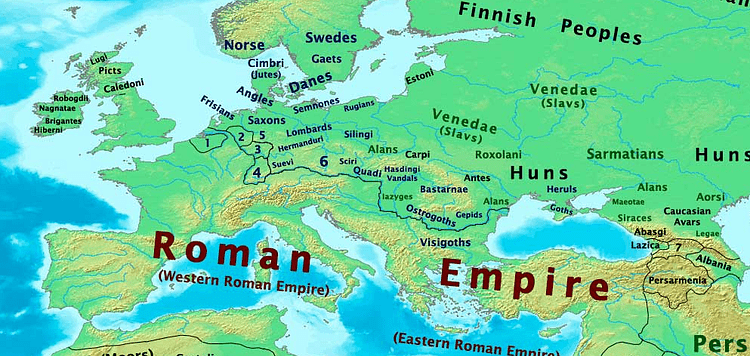
Athanaric's Persecution of the Christians
Christian missionary work among the Goths was primarily accomplished by a man named Ulfilas (also known as Wulfila, which means "little wolf") who lived c. 311-383 CE. Ulfilas was a Goth and an Arian Christian who translated the Bible from Greek into the language of the Goths and preached his version of Christianity (as opposed to Trinitarian Christianity) in the Gothic regions.
The historian Noel Lenski notes that the emperor Constantius II (reigned 337-361 CE) "was somehow actively involved with Ulfilas' work" (79). Ancient sources such as Sozomen indicate that the Goths began converting to Christianity, in small numbers, under the reign of Constantine the Great, and that there may have been other missionaries at work in the region before Ulfilas. If so, their names are not recorded, while Ulfilas' missionary work is well documented. He is said to have converted so many Goths to Christianity - which was considered a Roman religion by the Goths - that the chieftains feared the loss of their culture and way of life. Lenski writes:
Christianity in Gothic territory during the fourth century was common and well organized and reached even the upper echelons of Gothic society. Conversion was brought about through passive and active evangelical efforts undertaken by Christians both inside and outside Gothic territory, with encouragement not just from Roman ecclesiastical authorities but from the imperial administration. Finally, Gothic central leaders regarded Christianity as a real and present threat from Rome and acted on their perceptions by instituting two anti-Christian persecutions. (83)
The first of these persecutions had perhaps begun under Aoric but could have been under Athanaric in 348 CE. After the peace treaty with Valens was signed, the second wave of persecutions (369-372 CE) made martyrs of many Gothic Christians, the most famous of whom is Saba (also known as Sabbas) who was executed by drowning in 372 CE and made a saint by the early church. Wolfram writes:
The second Gothic persecution of the Christians was conducted far more systematically than the first one in 348. The Gothic persecutors were not content with isolated actions or the exiling of Christian tribesmen but instead aimed for complete extermination. The persecution was directed by Athanaric, who conducted it in the same way in which he had been leading the Danubian-Gothic confederacy since 365. (69)
A number of historians, Wolfram included, note that the history of these persecutions (like the history of the Goths themselves) was written by Christian Romans with a specific agenda in mind, and so the details of the persecutions could have been altered to better fit the story they wished to tell. Ulfilas is usually presented as the hero of the faith who fought against Athanaric, the enemy of God. While some details differ slightly, the ancient sources agree on how the persecutions divided the Goths under Athanaric, with some families concealing and saving their Christian relatives and others turning on them for betraying their heritage.
As with Christian persecutions elsewhere, before and after this time, the authorities ordered images sacred to their own faith to be carried from village to village so that the people could honor and make sacrifices to their ancestral gods. As Wolfram notes, "Whoever refused to do so was burned along with his dwelling; in other words, he suffered the punishment of someone who had violated the 'divine law' of the tribe" (69). Ulfilas had already fled the region with a number of his followers for the safety of Rome; those Christian Goths who remained were either systematically executed under Athanaric's orders or learned to hide their faith somehow. Athanaric was not trying to hamper the freedom of his people but, rather, was attempting to save them from what he saw as the corrupting influence of the Roman religion. Wolfram comments:
Athanaric's conservative policies were directed not so much against things Graeco-Roman as against Christianity mediated by the Romans. He feared that Christianity would dissolve the traditional social order of his people. Yet the brutal persecution could not heal the differences within the tribe. (69)
The Christian persecutions turned the Goths under Athanaric against each other throughout the region and, eventually, contributed to breaking them apart into two separate camps: one under the leadership of Athanaric and the other led by the Gothic prince Fritigern.
Athanaric & Fritigern
Fritigern is well known as the leader of the Goths who defeated Valens at the Battle of Adrianople in 378 CE and who publicly converted to Christianity two years before that in order to gain admittance to the Roman Empire. It is thought, however, that he had become a Christian years before. Fritigern was himself a reiks of his tribe, who had agreed to allow himself and his people to be led by Athanaric in order to repel the Romans.
Fritigern's response to the peace treaty with the Romans is not known nor is his response to the Christian persecutions for the first two years but, c. 372 CE, he led his forces against Athanaric and initiated the Gothic Civil War. Exactly why he did this is not clear, as it is unknown at what date Fritigern embraced Christianity. It is possible that Fritigern wanted to stop the persecutions but equally likely that, without the threat of a Roman invasion, he simply withdrew from the alliance and attempted a coup. It is generally believed, however, that he either was already a Christian or was sympathetic to the Christian cause prior to the outbreak of hostilities between him and Athanaric.
Another possibility suggested by Wolfram is that Fritigern "must have realized the possibility of profiting politically from the Christian persecution by switching sides" (70). He would have therefore abandoned his Gothic heritage in the hope that, by becoming a Christian, he would win the support of Rome. Lenski notes the way in which Rome used Christianity as a political tool, writing:
Christianity provided a diplomatic link between Rome and the independent eastern territories over which she claimed some influence. In this context, Valens' support of Christians north of the Danube makes perfect sense. Despite no firm evidence that he actively sponsored missionary efforts in Gothia, there is every reason to believe that, as elsewhere, he supported and encouraged Gothic Christians…This was clearly the case with Fritigern, who was favorable to Christians before he won Valen's support and who converted with his followers to strengthen his Roman ties. In his case, as in so many others, Roman leadership employed Christianity as a remote control to extend Roman influence among non-Romans and to manipulate affairs beyond Roman sway. (81)
In the early stages of the civil war, Athanaric defeated Fritigern and his ally, Alavivus, in every engagement. There appears to be no record of dates or battles in this conflict but, at some point, Fritigern requested help from Valens in defeating his rival. Ancient sources seem to indicate that, with Valens' help, Fritigern made some advances against Athanaric but ultimately it seems he lost the war.
Following his defeat, and with the Huns now making raids into Gothic lands and destroying vast resources, Fritigern requested permission from Valens for himself and his followers to settle in Roman Thrace in 376 CE. Valens agreed to this on the condition that Fritigern and his people convert to Arian Christianity and served in the Roman military.
There is evidence that Athanaric was also thinking of leading his people into Rome but feared reprisals from Valens for their earlier conflict. Further, Valens' agreement to allow Goths to settle in Roman lands was only offered to Fritigern and his followers, not to all Goths. Athanaric therefore maintained his position as judge/king of the Thervingi and, with Fritigern's departure for Rome, mobilized his forces to face the new threat of the Huns.
The Huns & the Migration of the Goths
The Goths under Athanaric had been at war, on and off, for almost ten years when the Huns began incursions into their region c. 376 CE. Athanaric mounted a defense between the Prut and Danube Rivers, building the fortification later known as Athanaric's Wall (also known as Southern Trajan's Wall, though historians are by no means in agreement that Athanaric had anything to do with its construction). The Huns overran his position but, as he had done with the Romans, Athanaric slipped quietly into the forests and escaped.

The Huns then established a stronghold just north of Athanaric's former position from which they conducted raids into his territories. According to the ancient sources, the Huns seemed to be able to strike anywhere and at any time. The Goth's crops and fields were destroyed and, as the region was still recovering from the war between Athanaric and Fritigern, this put a greater strain on the food supply. The supply lines to Athanaric's forces collapsed as the Hunnic raids came more and more unexpectedly. Many Goths attempted, and succeeded, in crossing the Danube and following Fritigern's lead of settling themselves and their families in Roman territory, while others remained and tried to hang on to their ancestral lands and culture, but it was no use. Wolfram writes:
The Thervingi had no hope of surviving in a ravaged land that a new type of enemy could destroy at will, practically without advance warning. No one knew how to defend against the Huns, not even Athanaric who in his days had outmaneuvered the Romans. At this critical time the leaders of the opposition - the friends of Rome and the Christians, that is, the former enemies of the Thervingian judge - offered a credible alternative...and promised flight into the Roman Empire as the only means of salvation. The majority of the Thervingi thereupon deserted Athanaric, thus bringing the Thervingian judgeship to an end. (72)
The Huns continued their invasion of the region and, as Wolfram writes, citing the ancient source of Ambrose, the chaos this caused was widespread: "the Huns fell upon the Alans, the Alans upon the Goths, and the Goths upon the [tribes of] the Taifali and Sarmatians" (73). These populations fled across the Danube for the safety of the Roman Empire. Athanaric, with those Thervingi who still followed him, took his people in a different direction and conquered the Sarmatian tribe of the Caucaland in the Alutus Valley (Transylvania). Athanaric settled his people in their new home and tried to resume his old position as king but, for unknown reasons, the tribe rejected him and drove him out of their new territory sometime in 380 CE.
Constantinople & the Death of Athanaric
No longer a judge of the Thervingi, and with no followers, Athanaric had nowhere to go except to his old enemy: the Roman Empire. Forgetting his vow to his father, and no longer constrained by religious/cultural principles, he made his way to Constantinople where he was well received in 381 CE by the new emperor Theodosius I (r. 379-395 CE), Valens having been killed at the Battle of Adrianople in 378 CE.
Some historians have speculated that, since Athanaric was somehow able to travel through hostile territory patrolled by Roman troops all the way from the Alutus Valley to Constantinople unmolested, some agreement with Theodosius I had been reached beforehand. If so, such an agreement may have been regarded as a betrayal by his people and resulted in his expulsion from the tribe. Gothic resentment toward Rome was high at this time, and perceived collaboration with the enemy would hardly have been tolerated. It should be noted, however, that this theory is speculative and there seems no way to definitively prove it.
The Goths under Fritigern had rebelled against Rome because of the poor treatment they received from Roman provincial administrators and, at the time Athanaric arrived in Constantinople, had been gaining ground in their war for three straight years. Theodosius I was interested in pacifying the Goths and so thought it a prudent gesture to receive their former king with all honors. The course of action may have been suggested by an advisor to the emperor, Themistius (317-390 CE), who had been with Valens when he signed the peace treaty with Athanaric on the Danube in 369 CE. It is clear from Themistius' account of that meeting that he held Athanaric in high regard and so would have felt that the former king should be accorded the honors due him.
Athanaric was treated to a grand reception where he was seated with the emperor and the distinguished upper class of Constantinople on 11 January 381; two weeks later he was dead. The cause of his death is unknown, but it appears to have been unexpected. Wolfram writes, "Athanaric's death had come as something of a surprise; there were even rumors of a violent end, which means that the former Gothic judge was probably not an old man" (74). Theodosius I insisted on a grand funeral for the dead king with all imperial protocol as a means of further pacifying the Goths in rebellion.
Athanaric's tomb was said to be so ornate that it stunned those who attended the funeral. It was Theodosius' intention to show that he respected the Goths, their leaders, and their culture, by personally seeing to it that their fallen king was laid to rest with full honors. He may have been correct in this; the following year, 382 CE, the Goths signed the peace treaty ending the conflict and would remain at peace with the Roman Empire until Theodosius' death in 395 CE. Although Athanaric's grand funeral was not the sole cause of the peace, nor was Theodosius' death the cause of renewed hostilities, both are thought to have contributed toward those ends. Wolfram writes:
Thervingian history during the decade before the invasion of the Huns is dominated by the figure of Athanaric, who has fascinated posterity as he did his contemporaries. The Visigoths of the seventh century still remembered Athanaric as their 'founder king'. (64)
Athanaric ruled over his people during one of the most critical times in their history and, although he may be held accountable for some errors in judgment regarding his Christian policies and the effects these had on his people, he always seems to have tried to do what he felt was in their best interests. Although he surrendered to Rome at the end and was given a Roman funeral, his struggle against the Roman Empire and the injustices he felt it practiced would be renewed later by his relative, Alaric I, who, in 410 CE, sacked the city of Rome.

